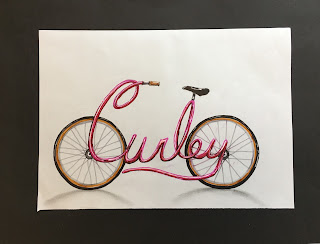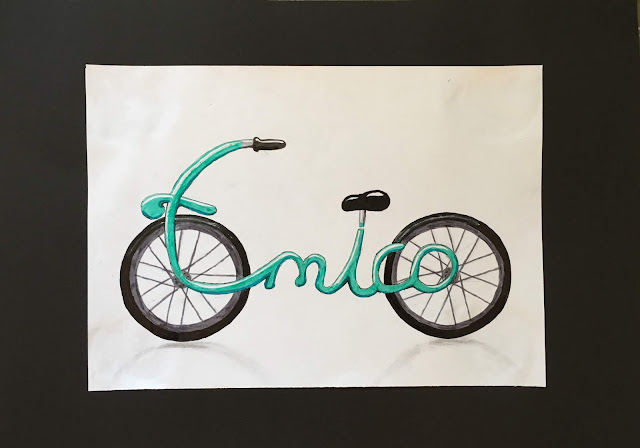 |
| Jure Zaech designs |
 |
| Juri Zaech design |
I've been wanting to try out these personalized bike frames with my students for a while, ever since I learned about the Swiss designer and typographer Juri Zaech. I think the idea of a name bike frame is just wild and so original, and one my 8-14 year old kids could get behind with enthusiasm. Additionally, I was looking for a perfect project to start the new Art Room fall semester. Last year, we did a graffiti project as our first project of the fall semester, and this bike project covered all the same territory and more! It was a great way for my students to get back into the art swing of things after a long summer break: line, shadows, highlights, dimension, proportion, precision, color, emphasis, design and design development are all elements, principles and areas we considered in this project.
 |
| Teacher Sample |
To start, we talked about scripts. I handed my kids several different script fonts I'd downloaded from the internet. This allowed them to see how letters swing and curve into each other, and how much variation there is in different scripts. This was especially important for those kids who had never learned to write cursive in school. My kids come from two different school systems: The German school system, which teaches cursive writing in second grade, and the International school system, which did away with cursive instruction all-together. We practiced our names on scrap paper many times over, using different scripts, or just exploring script. We knew our names would be turned into bike frames, so had to consider a placement for our bike seat and handlebars. If we thought our name was too short, or not suitable, we chose our second name or our last name. Like designers, students were problem-solving, experimenting, and finding solutions to make their names fit into their concept: where will the bike seat go? how will I incorporate the handle bars into my first letter? where might I attach the wheels? how much room must I leave for the wheels? is my name too short? is my name too long? (if so, could I make a two-seater bike?)....
When we had our name and our script chosen, we got out the good paper and began carefully drawing our name. I used marker paper for this project, because it holds the marker color much better than regular printer paper, which often tears and gets distressed. Marker paper allows the marker to glide on smoothly, and absorbs the color just enough without tearing, allowing the color to stay vibrant.
Names: Students were encouraged to center their name, with equal space to the right and left of their name, and enough space at the bottom of their name for wheels and shadows. Placement (composition) is important! We drew lightly with pencil (something I stress again and again), so we could erase and correct if needed. Once names were drawn, we doubled up our lines and created thicker lettering, so we could color it in later (going from line, to shape). This reminded us of the graffiti lettering we did last year.
Details: Once we had thick name lettering, we added our seat, our handle bars and grips. I had many visuals of bikes, in different styles, so kids could look closely at how to draw handlebars and seats, and how they are placed in relation to each other. Some kids had to be encouraged to draw their seats larger - we discussed proportion and scale.....
Wheels: For the wheels we used empty masking tape rolls as tracers. We were careful to find the right placement for our wheels - not too far apart, not too close together. Students used a ruler to create a horizontal guide for placing their wheels on the same line - we did not want one wheel higher or lower than the other!
Spokes: The spokes were tricky. I did not want to draw simple 'pizza pie' spokes, with lines coming out vertically from the wheel center. I wanted students to attempt 'proper' spokes, which are slightly crossed over each other, and which spiral in both direction from the center. We watched a simple youtube tutorial on how to draw spokes, then I demonstrated a few times on the white board before students practiced on their scratch paper. It took a few attempts, but we finally go it!
 |
| Day 1 complete |
Coloring: We wanted a 3-D looks, so highlights and shadows were critical. Students chose a light source, and then colored accordingly. We chose one color, plus a lighter and/or darker value of that color (for example: RED, plus dark red and pink). I demonstrated that when coloring with marker, strong highlights (white areas) must be left uncolored. To do this, we used our lightest base color and drew in our highlight shapes where we wanted them, then colored in our whole bike, going around these shapes, leaving them white. We then added a middle value and shadows with our middle and darker colors. We noted that shadows go anywhere where one part of our lettering crosses over top of another part, underneath our lettering, in corners and at the far side from where our light source is coming from. Similarly, highlight are close to the light source, facing the light source, or near the top of lettering. Seats, handlebars and grips also had highlights and shadows.
Finishing Touches: With a fine liner black permanent marker, we went over our contour lines where we felt it was necessary, either to add an additional darker edge to our shadow sides (creating more dimension) or to lightly contour or emphasize the whole bike (for example, if our bike color was light).
Shadows: To give our bikes some weight and grounding, we added a fine wheel shadow. Using a piece of vine charcoal, we etched a bit of chalk right under the wheel, then with our finger, we pulled the chalk outwards to the left and to the right, in a large arched motion, fading the shadow as it extends downwards, because shadows get lighter as they extend away from their object. We talked about cast shadows, and how the sun, when it shines from behind you, makes your shadow look larger than you.... so it was with our wheels.
This project took two-90 minute classes. All my students, aged 8-14, went home feeling accomplished. They loved this project.













